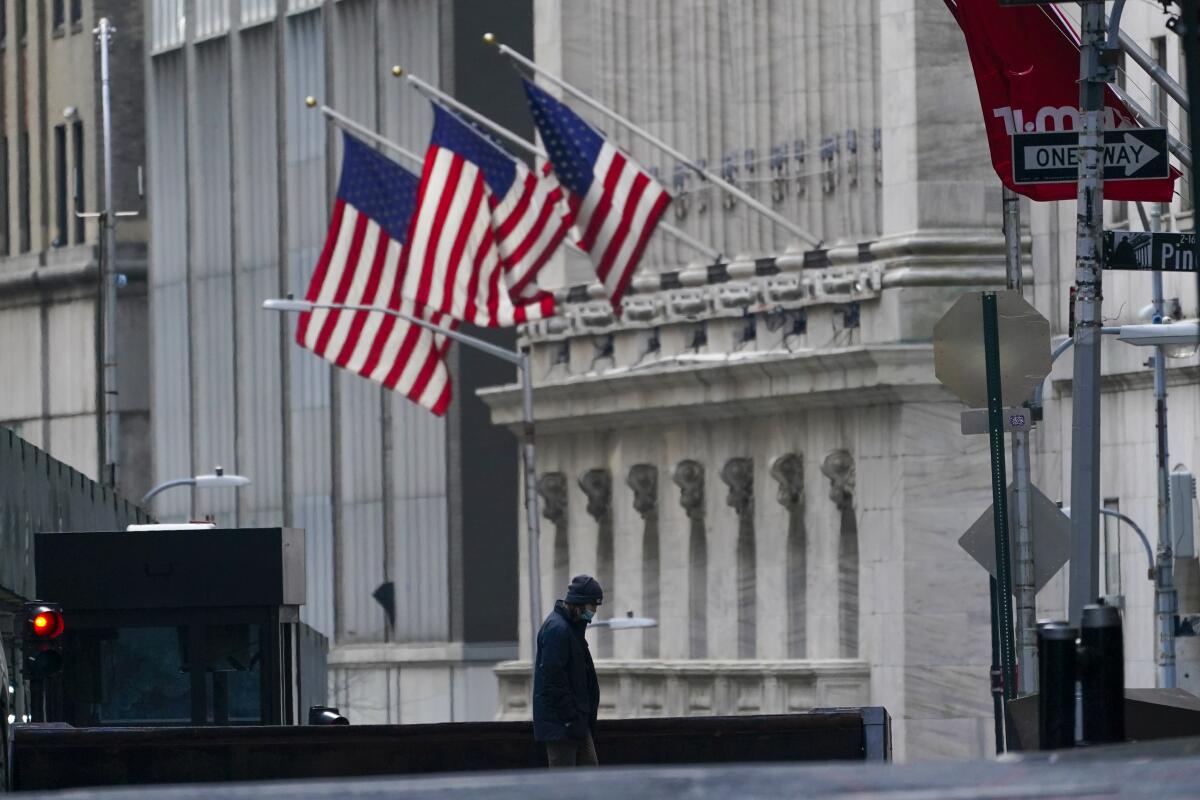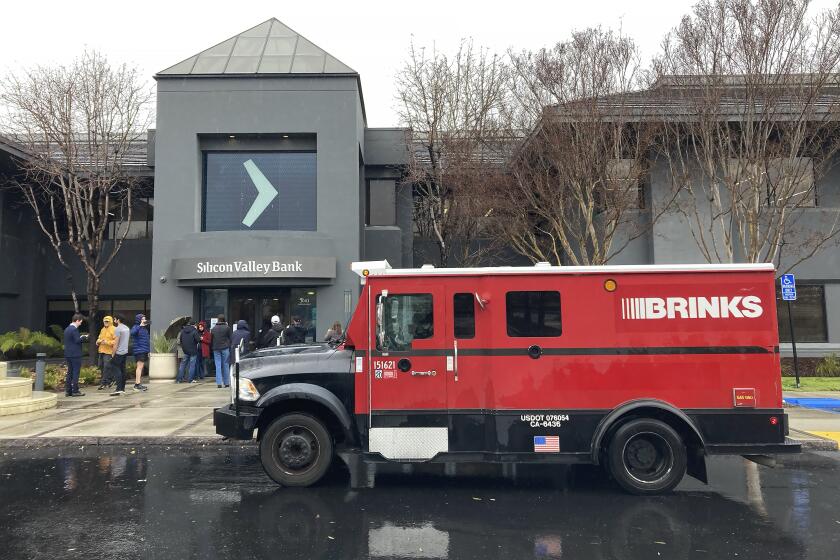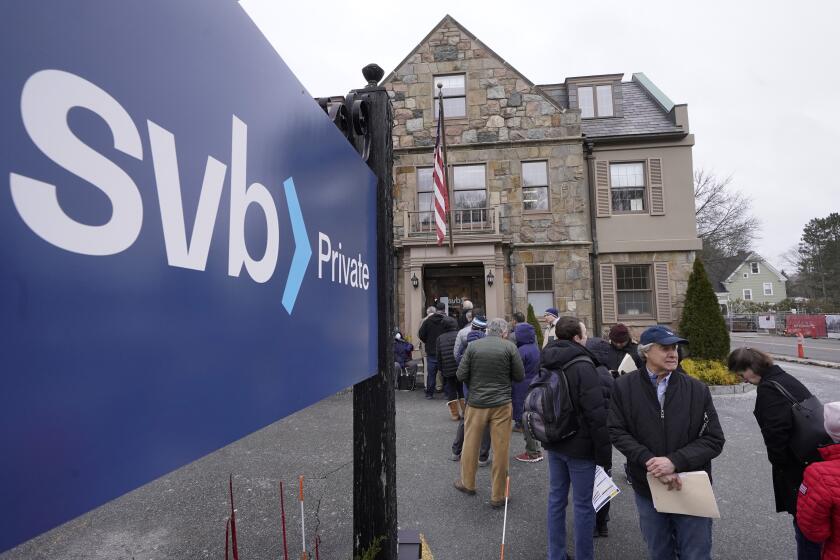Stocks fall to cap chaotic week driven by fears about banks

- Share via
A whipsaw week for Wall Street closed with drops for stocks Friday as worries worsened about the banking industry and fears rose that it could drag the economy into a recession.
The Standard & Poor’s 500 sank 1.1%, cutting into its gain for the week. The Dow Jones industrial average lost 384 points, or 1.2%, while the Nasdaq composite fell 0.7%.
Markets around the world churned this week as worries rose after the second- and third-largest U.S. bank failures in history. On Thursday, markets rallied in relief after two banks in investors’ crosshairs bolstered their cash holdings.
But on Friday, some of that hope faded and the two banks were back to falling. Credit Suisse shares dropped nearly 7% and shares of First Republic Bank sank nearly 33% to bring their plunge for the week to 71.8%.
The two banks have different sets of issues challenging them, but the overriding fear is that the banking system may be cracking under the weight of the fastest set of interest rate hikes in decades.
Financial turmoil has some people wondering if a systemic problem is putting all banks in peril, as in the Great Recession. Experts say that isn’t the case.
“If the Fed hikes this far this fast, something will break,” said Ross Mayfield, investment strategy analyst at Baird. “There’s a very clear and evident history of that happening, even in slower, smaller rate-hike cycles.”
Analysts have been quick to say the current chaos for banks looks nowhere near as bad as the 2008 financial crisis that ruined the global economy. But the troubles still feed into concerns about a recession because problems for banks could mean problems for smaller and midsize companies getting the loans they need to grow.
In “the biggest picture: since 1870 there have been 14 big world recessions, all driven by wars, pandemics & banking crises,” investment strategist Michael Hartnett wrote in a BofA Global Research report.
Silicon Valley Bank and Signature Bank have received $143 billion from the Federal Reserve. Other banks have borrowed nearly $165 billion from the central bank over the last week, a sign of how much stress is on the system.
After years of enjoying historically easy conditions, banks and the economy are now getting a shock after the Federal Reserve and other central banks jacked up interest rates at a blistering pace. The moves are meant to get high inflation under control.
Higher rates can indeed help tame inflation by slowing the economy, but they raise the risk of a recession later on. They also hurt prices for stocks, bonds and other investments. That latter factor was one of the issues hurting Silicon Valley Bank, which collapsed March 10. High rates had undercut the value of its bond investments.
SVB Financial Group is no longer affiliated with Silicon Valley Bank since it was seized by the Federal Deposit Insurance Corp.
Since then, Wall Street has tried to root out banks with traits similar to Silicon Valley Bank’s, such as having lots of depositors with account balances higher than the $250,000 limit that’s insured by the Federal Deposit Insurance Corp., or having a focus on tech startups and other highly connected people who can spread worries about a bank’s strength quickly.
That’s why Wall Street has keyed in so much on San Francisco-based First Republic. A group of 11 of the biggest banks on Thursday said they would deposit a combined $30 billion in the bank to show their confidence in it and in banks in general. After getting a brief respite Thursday, First Republic’s stock fell sharply again Friday along with other smaller and midsize banks.
“There’s still a lot of unknowns,” Baird’s Mayfield said about what types of investments banks have in their portfolios and how easily they can be turned into cash quickly. “That’s the biggest fear. That’s when markets are typically at their most volatile and most negative. And for most investors who have been in the business for a while, it’s hard not to call back to memory 2008, 2009 even if it does look quite different.”
Some of the wildest action has been in the bond market, where yields have swung as traders drastically recalibrate bets for where the Fed will take rates.
The yield on the two-year Treasury dropped to 3.81% from 4.17% late Thursday. It was above 5% last week, its highest level since 2007. That’s a massive move for the bond market.
Traders largely expect this week’s turmoil to push the Federal Reserve to hike interest rates at its next meeting by only a quarter of a percentage point. That would be the same size as last month’s increase and half the increase that some traders were earlier expecting.
A report on Friday possibly gave the Fed more reason to hold off on reaccelerating its rate hikes, as it had earlier signaled it might do. Expectations among U.S. consumers for inflation in the year ahead fell to their lowest level in nearly two years, according to a preliminary survey by the University of Michigan. That’s key for the Fed, which has said such expectations can feed into virtuous and vicious cycles.
In a more discouraging signal for the economy, though, confidence also fell. That’s at the heart of the most important part of the U.S. economy: consumer spending.
Easing expectations for the Fed have helped several major tech companies lead the market this week. They’ve had their own problems, but they tend to benefit from lower interest rates. Partly because of that, the S&P 500 still notched gains for the week.
All told, the S&P 500 fell 43.64 points Friday to 3,916.64. The Dow slipped 384.57 points to 31,861.98, and the Nasdaq fell 86.76 points to 11,630.51.
Cryptocurrencies have shot even higher this week. Bitcoin is up more than 30%.
AP writers Elaine Kurtenbach and Matt Ott contributed to this report.
More to Read
Inside the business of entertainment
The Wide Shot brings you news, analysis and insights on everything from streaming wars to production — and what it all means for the future.
You may occasionally receive promotional content from the Los Angeles Times.












